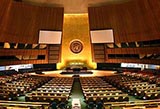
One ring to rule them all
UN Security Council: Vetoing Change
Thank God there is the UN Security Council. After the tens of millions of casualties resulting from World War II, a global watchdog body made up of the powers on the “good” side of the war plus a number of other countries in a rotating membership basis could only be a good thing. It would nip conflicts in the bud, with its ability to impose binding resolutions and authorise the use of armed force. The permanent members’ power to wield a veto, in turn, would make sure that no single country could run amok as Germany and Japan had done.
Alas, it didn’t take long for the “good” powers to drift apart and start snarling at each other. The power of veto mutated into a tool, first for the USA and the USSR, lately for Russia, to defend petty interests. The Security Council was obviously ripe for reform, with deliberations beginning twenty years ago by the Open-Ended Working Group. Seldom has there been a more aptly named body. Two decades on it is still going, with nothing to show for it.
Which reforms are being proposed, and what difference will they make if they are adopted? CESifo researcher Matthew D. Rablen and his colleague Matthew Gould have delved into the matter, producing the first quantitative study of the equity and efficiency of these proposals.
Under the present arrangements, the 15 UNSC members comprise five veto-wielding Permanent Members—China, France, Russia, the United Kingdom, and the United States—and ten Non-Permanent Members (NPMs) which serve two-year terms. The latter are elected on a regional basis.
Two distinct sets of criticism are levelled at these arrangements: one relating to the efficiency of their operation, the other relating to how they achieve equity in the allocation of political power.
On efficiency, critics argue that the UNSC is too often impotent, not least because of the veto power wielded by the Permanent Members, which allows them to block a resolution backed by all remaining members. In other cases, the UNSC has been too slow to react, prompting powerful countries to bypass it and undertake military action without a UNSC mandate, such as in Kosovo and Iraq.
In terms of equity, the voting power of such populous countries as India is far too low, but far too high when awarded to smaller countries. For the Permanent Members, the conjunction of voting power and permanent presence gives them too much representation. Asia and Africa are substantially, and Latin American and the Caribbean somewhat less substantially, under-represented. There is also a North-South imbalance.
The authors apply new equity measures to the issue and impose each structural reform while holding the size of the Security Council constant, so as to capture the pure effect of the reform. They then expand the resulting council along an “expansion path” to separately observe the effects of expansion.
The authors find that only two of the eight structural reforms considered, and only one of the eleven reform proposals put forth, improve upon the status quo in both equity and efficiency. One worsens everything, while another three worsen equity but leave efficiency unchanged. Part of the problem, they find, is that expansion would be good for equity but bad for efficiency.
Surprisingly, the authors find no compelling support for the abolition of the veto. What they do find is that requiring two Permanent Members to vote against a resolution for a veto to be constituted would improve both equity and efficiency—albeit modestly: it lessens the dominance of the Permanent Members by reducing their voting power instead of by requiring them to lose their right to permanent representation. However, if this reform is accompanied by an expansion of the UNSC by five or more members, the efficiency gain is completely obliterated.
In sum, expansion at the levels currently under consideration would provide only modest improvements in equity and will come at the expense of efficiency—unless world leaders are also willing to relax the threshold for the proportion of members that must vote in favour of a resolution for it to pass. Two of the structural reforms put forth—labelled PNVM and Renew, respectively, in the table—would even worsen the Council’s woes.
Ultimately, reality has shown that when the interests and responsibilities of the members of an organisation are not shared equally, the functioning of such organisations may be impaired if these inequalities are not reflected in the voting system. Examples of this are the now defunct League of Nations and the International Trade Organisation, which failed precisely because they could not accommodate the interests of the US and other Western powers in the voting procedures.
So, patience is called for. Not only will the veto powers be reluctant to give up their privileges. The diverging interests and aims of the regional groupings and countries will help to make sure that the Open-Ended Group will celebrate many more anniversaries. No wonder that the authors ran a computer simulation of the UNSC under each structural reform over a period of 100,000 years…
Other CESifo Working Papers by Matthew Rablen
This text is the responsibility of the writer and does not necessarily represent the opinion of the authors of the paper featured.
